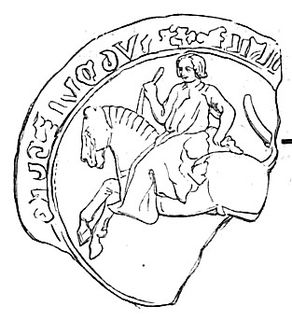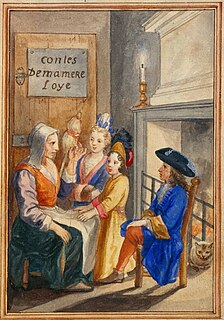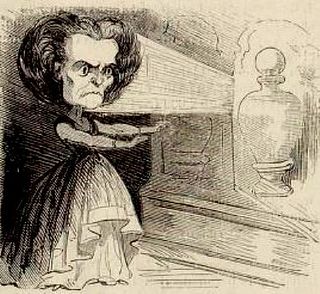Jean d'Arras (fl. 1392-94) was a 14th-century Northern French writer about whom little is known.
He collaborated with Antoine du Val and Fouquart de Cambrai in putting together a collection of stories entitled L'Évangile des quenouilles ("The spinners' gospel"). The frame story is a group of ladies at their spinning who relate the current theories on a great variety of subjects. The work is of considerable value for the light it throws on medieval manners, and for its echoes of folklore, sometimes deeply buried under layers of Christianity.
There were many editions of this book in the 15th and 16th centuries, one of which was printed by the early printer Wynkyn de Worde in English, as The Gospelles of Dystaves. A more modern edition (Collection Jannet) had a preface by Anatole France.
Jean d'Arras, perhaps the same, wrote at the request of John, duke of Berry, as he says in his introduction, a long prose romance variously called the Roman de Mélusine or the Chronique de Melusine part of Le Noble Hystoire de Lusignan ("The Noble History of the Lusignans"), in 1392-94. He dedicated the work to Marie of Valois, Duchess of Bar and expressed the hope that it would aid in the political education of her children.
Leaning on perhaps mostly oral tradition surrounding the originally Celtic region of Poitou, it is one of the first literary versions of the tale of Melusine, a fairy cursed by her fairy mother to become a hybrid woman/serpent every Saturday. If she married a mortal man who remained faithful to her and obeyed her request never to seek her out on that day, she would gain the status of a mortal woman and enjoy salvation as a Christian. She guided the spectacular rise and subsequent fall of the House of Lusignan after she met the nobleman Rainmondin by a fountain in the forest, who married her and fathered ten sons on her whose exploits in the Crusades brought them fame, despite the fact that most of them carried some form of physical blemish. Raimondin remains faithful to his promise until he is persuaded to believe that her hiding every Saturday is an excuse for her to entertain a lover, and he spies on her in her bath. He doesn't betray her secret until one of their most deformed sons, Geoffrey Big-Tooth, burns down the monastery his brother Fromont has retired to. In despair, Raimondin curses her publicly for her demonic nature that has infected their sons, and she turns into a dragon and flies away, wailing. For more information consult the Wikipedia article on Melusine.

Renaud de Montauban, German: "Reinhold von Köln" was a legendary hero and knight which appeared in a 12th-century Old French chanson de geste known as The Four Sons of Aymon. The four sons of Duke Aymon are Renaud, Richard, Alard and Guiscard, and their cousin is the magician Maugris. Renaud possesses the magical horse Bayard and the sword Froberge.

Mélusine or Melusina is a figure of European folklore, a female spirit of fresh water in a holy well or river. She is usually depicted as a woman who is a serpent or fish from the waist down. She is also sometimes illustrated with wings, two tails, or both. Her legends are especially connected with the northern and western areas of France, Luxembourg, and the Low Countries. Her name can vary depending on the areas such as Merlusse in Vosges, Merluisaine in Champagne.... The French Littré suggests the Latin melus, meaning "melodious, pleasant".

Leo V or Levon V, of the House of Lusignan, was the last Latin king of the Armenian Kingdom of Cilicia. He ruled from 1374 to 1375.

Bonne of Luxemburg or Jutta of Luxemburg, was born Jutta (Judith), the second daughter of John the Blind, king of Bohemia, and his first wife, Elisabeth of Bohemia. She was the first wife of King John II of France; however, as she died a year prior to his accession, she was never a French queen. Jutta was referred to in French historiography as Bonne de Luxembourg. She was a member of the House of Luxembourg. Among her children were Charles V of France, Philip II, Duke of Burgundy, and Joan, Queen of Navarre.

The House of Lusignan was a royal house of French origin, which at various times ruled several principalities in Europe and the Levant, including the kingdoms of Jerusalem, Cyprus, and Armenia, from the 12th through the 15th centuries during the Middle Ages. It also had great influence in England and France.

As a literary genre of high culture, heroic romance or chivalric romance is a type of prose and verse narrative that was popular in the noble courts of High Medieval and Early Modern Europe. They were fantastic stories about marvel-filled adventures, often of a chivalric knight-errant portrayed as having heroic qualities, who goes on a quest. It developed further from the epics as time went on; in particular, "the emphasis on love and courtly manners distinguishes it from the chanson de geste and other kinds of epic, in which masculine military heroism predominates."

Medieval French literature is, for the purpose of this article, Medieval literature written in Oïl languages during the period from the eleventh century to the end of the fifteenth century.

The Château de Lusignan, of which hardly any traces remain, was the ancestral seat of the House of Lusignan, Poitevin Marcher Lords, who distinguished themselves in the First Crusade and became the royal family of the Kingdom of Jerusalem, the Kingdom of Cyprus and the Armenian Kingdom of Cilicia. Built in the 10th century, it reached its peak four centuries later, decayed and was finally dismantled in the 18th century.

Hugh IX "le Brun" of Lusignan was the grandson of Hugh VIII. His father, also Hugh, was the co-seigneur of Lusignan from 1164, marrying a woman named Orengarde before 1162 or about 1167 and dying in 1169. Hugh IX became seigneur of Lusignan in 1172, seigneur of Couhé and Chateau-Larcher in the 1190s, and Count of La Marche on his grandfather's death. Hugh IX died on the Fifth Crusade at the siege of Damietta on 5 November 1219.

Marie of France was the sixth child and second daughter of John II of France and Bonne of Bohemia.
French folklore encompasses the fables, folklore, fairy tales and legends of the French people.
Yolanda of Lusignan or Yolande I de Lusignan, Countess of La Marche was a French noblewoman and peeress. In 1308, she succeeded her brother Guy I as suo jure Dame of Lusignan, of Couhé and of Peyrat, and suo jure Countess of La Marche, but not as Countess of Angoulême since after her brother's death the county was sold by her sisters, Joan and Isabelle, to King Philip IV and annexed to the French Crown. Yolanda was also the heiress of Fougères, which she succeeded to upon her mother's death sometime after 1273.
Sylvia Huot is a professor of Medieval French Literature at the University of Cambridge and fellow of Pembroke College. She is the author of several internationally renowned books on Medieval French Literature and the leading expert on the manuscripts of Roman de la Rose, having published extensively on its iconography.

Robert I of Bar was Marquis of Pont-à-Mousson and Count and then Duke of Bar. He succeeded his elder brother Edward II of Bar as count in 1352. His parents were Henry IV of Bar and Yolande of Flanders.

Jeanne de Fougères, was ruling suo jure Lady of Fougères from 1256. She was the wife of Hugh XII of Lusignan, Count of La Marche and Count of Angoulême. Jeanne was responsible for the later additions and fortifications of the Chateau of Fougères which provided a greater stability for the town.

Histoires ou contes du temps passé, avec des moralités or Contes de ma mère l'Oye is a collection of literary fairy tales written by Charles Perrault, published in Paris in 1697. The work became popular because it was written at a time when fairy tales were fashionable amongst aristocrats in Parisian literary salons. Perrault wrote the work when he retired from court as secretary to Jean-Baptiste Colbert, minister to Louis XIV of France. Colbert's death may have forced Perrault's retirement, at which point he turned to writing. Scholars have debated as to the origin of his tales and whether they are original literary fairy tales modified from commonly known stories, or based on stories written by earlier medieval writers such as Boccaccio.

Hierges Castle is a partially ruined castle in the commune of Hierges in the Ardennes département of France. It is privately owned and has been listed since 1980 as a monument historique by the French Ministry of Culture.

El unicornio, translated in English as The Wandering Unicorn(1965), is a novel by the Argentinian author Manuel Mujica Láinez (1910–1984) in which the legend of Melusine is developed. Set in medieval France and Palestine of the Crusades, Láinez’s novel is a mixture of fantasy and romance which is narrated from the perspective of the shape-changing Melusine.

La magicienne is a grand opera in five acts composed by Fromental Halévy. The libretto by Jules-Henri Vernoy de Saint-Georges is based on stories surrounding the European folk figure Melusine, especially Coudrette's 15th-century Roman de Mélusine. The opera premiered on 17 March 1858 at the Théâtre de l'Académie Impériale de Musique in Paris. It had a mixed reception and after its initial run of 45 performances was not heard again until it was revived in a heavily cut concert version performed in Montpellier in 2011.
Sebile, alternatively written as Sedile, Sebille, Sibilla, Sibyl, Sybilla, and other similar names, is a mythical medieval queen or princess who is frequently portrayed as a fairy or an enchantress in the Arthurian legends and Italian folklore. She appears in a variety of roles, from the most faithful and noble lady to a wicked seductress, often in relation with or substituting for the character of Morgan le Fay. Some tales feature her as a wife of either King Charlemagne or Prince Lancelot, and even as an ancestor of King Arthur.